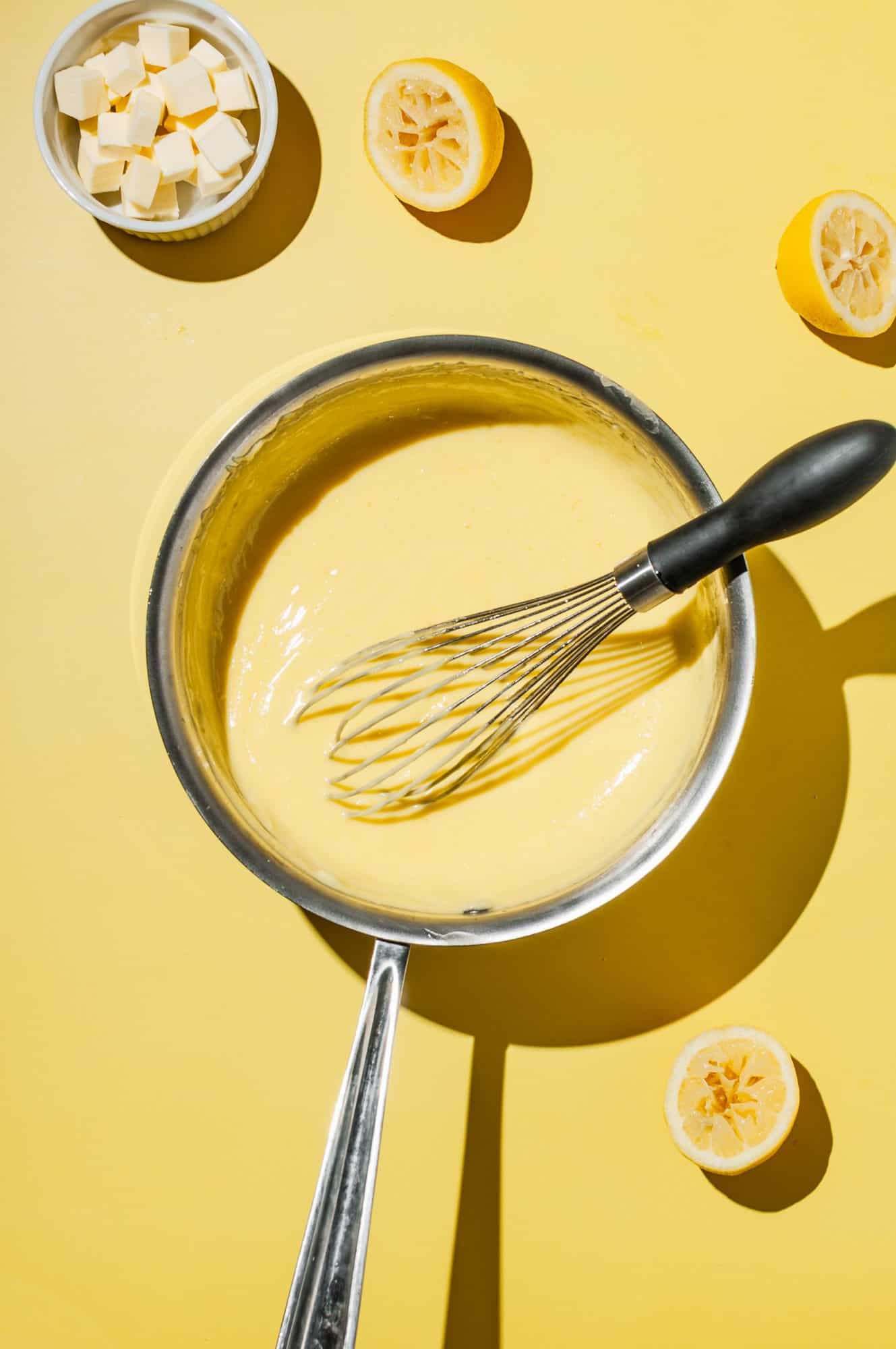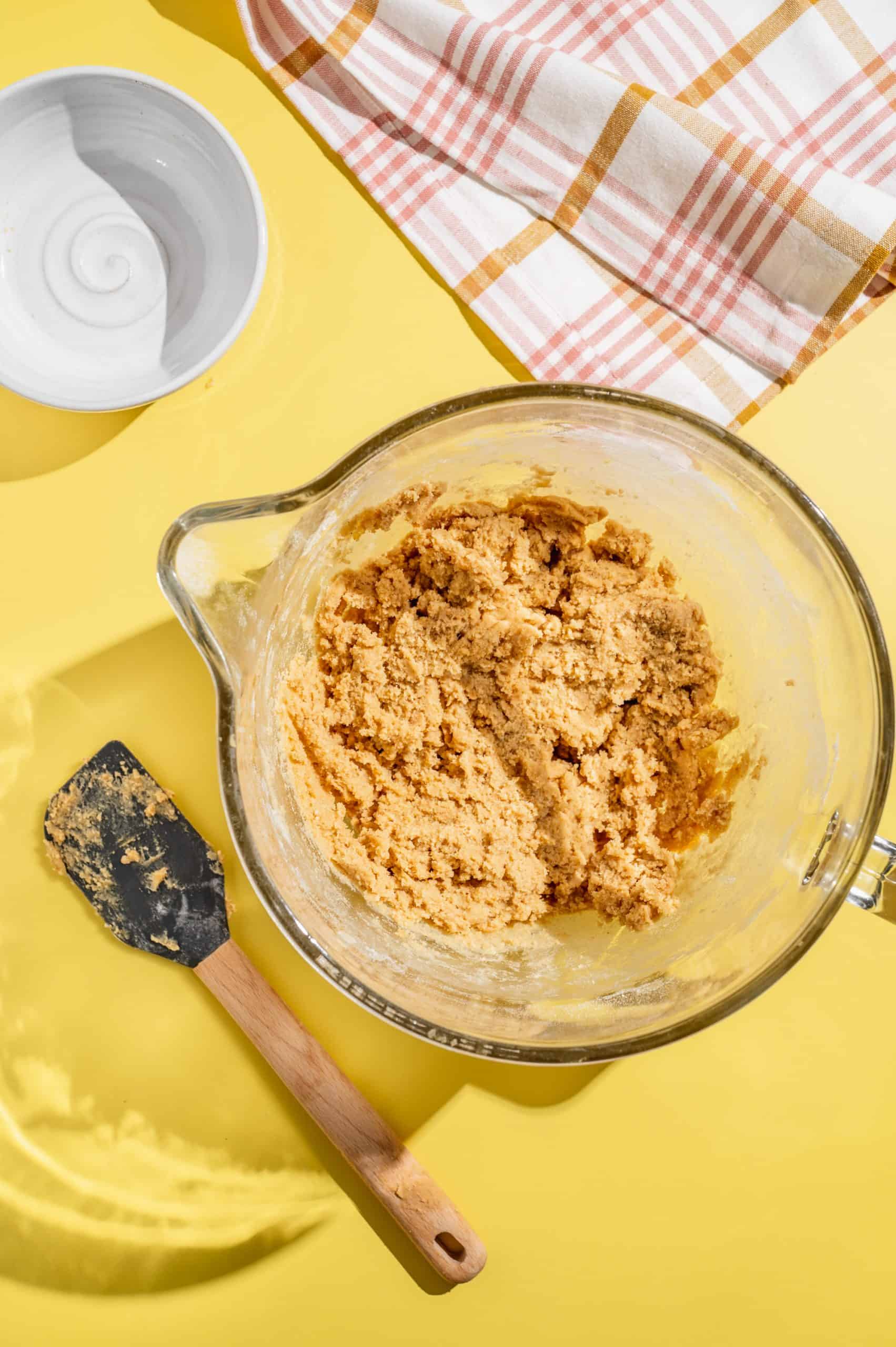These delicious lemon meringue pie cookies have all the same flavors as my popular lemon meringue pie with a graham cracker crust, in a cookie version! Instead of a pie crust, the vibrant tart lemon curd sits on a chewy sugar cookie made with graham cracker crumbs. Then they're topped with fluffy toasted meringue. YUMmm!

With a chewy texture and toasty sweet flavor, the cookie is similar to my s'mores chocolate chip cookies (without the chocolate and marshmallow mix-ins). The sweet, lightly spiced graham cracker flavor pairs perfectly with the tart lemon filling!
For another delicious fruity cookie recipe, try my homemade Raspberry Rally cookies next!
Jump to:
Why You'll Love This Recipe
- Vibrant fresh lemon curd paired with graham cracker flavor is an unbeatable combo! Just like key lime pie traditionally uses a graham cracker crust, it's the best vessel for creamy citrus fillings.
- The chewy graham cracker cookies are easy to make and way more flavorful than your usual thumbprint cookie.
- Lemon meringue pie cookies are visually stunning and sure to impress at a party or event! Perfect for a baby shower, bridal shower, Mother's Day brunch, etc. This recipe makes about 2 dozen cookies and can easily be doubled.
- Foolproof Swiss meringue holds up for days and is easy to pipe, making you feel like a professional baker.
Ingredients
Here's what you need to make these impressive lemon meringue cookies:

- Eggs - the lemon curd uses only egg yolk while the meringue uses an equal number of egg whites. So you don't have to worry about leftover yolks or whites.
- Salt - an important flavor enhancer even for sweet desserts.
- Cornstarch - thickens the lemon curd to the perfect consistency. Sturdy enough for thumbprint cookies but still super smooth and creamy.
- Lemon juice - freshly squeezed citrus juice has a brighter and less bitter flavor than bottled lemon juice at the store.
- Sugar - granulated sugar is used in all 3 components of these cookies (the lemon curd, meringue, and thumbprint cookies).
- Butter - used in the cookies for the perfect chewy texture. We also add butter to the lemon curd for the perfect rich, creamy mouth feel.
- Cream of tartar - added to stabilize the meringue and give it the best fluffy texture.
- Vanilla extract - lends flavor to the meringue and cookies.
- Brown sugar - light brown sugar is milder in flavor which works better for this recipe.
- Graham cracker crumbs - you can buy graham cracker crumbs to save time, or buy whole graham crackers and pulverize them to a fine crumb.
- Flour - all-purpose. You can substitute almond flour or a gluten-free flour blend if you prefer.
See recipe card for quantities.
How to Make Lemon Curd for Cookies

First, whisk together eggs, egg yolks, cornstarch, and salt in a large bowl. In a large pot, add the lemon juice and sugar and bring to a low boil. Then, slowly add the hot lemon mixture to the egg mixture a little bit at a time while whisking until smooth. I like to do this using a ladle to slowly drizzle it in.

Return the lemon curd mixture to the pot (it will be thin and watery at this point). Set over medium heat and cook until thickened, stirring constantly. (Cornstarch activates at around 180 °F at which point it will thicken rapidly). Once thickened, immediately remove the pot from the heat in stir in cold butter.
Let the lemon curd cool slightly, then transfer to a bowl, and cover with plastic wrap to prevent a film from forming on the top.
Lemon curd takes a few hours to fully set and it will thicken as it cools. In this recipe, you can fill the thumbprint cookies with partially set lemon curd and it will fully set after filling the cookies. Another option is to make the lemon curd ahead of time and fill the thumbprint cookies with fully set lemon curd.
Food Science Tip: Tempering Eggs
When making curd or custard (like creme brûlée), you need to combine cold or room-temperature eggs with a hot liquid. It's important to do this slowly. Otherwise, the eggs will clump or curdle and ruin your smooth textured dessert.
To temper eggs for lemon curd, slowly drizzle in a ladle full of the hot lemon mixture while whisking constantly. Once you've added about three-quarters of the mixture using a ladle, you can slowly pour in the remainder.
How to Make Lemon Curd Thumbprint Cookies
Here, I'll show you how to make thumbprint cookies with lemon curd:

First, cream together the butter, sugar, and brown sugar until light and fluffy.

Then, add the eggs, vanilla, and salt, and continue to beat until well combined.

Finish the cookie dough by adding the graham cracker crumbs and flour and mix on low speed. Try not to over-mix. At this point, you can refrigerate the dough until ready to use (up to overnight) or you can skip the chill and bake the cookies immediately.

Form cookie dough in balls 1.5 tablespoons each, roll in granulated sugar, and place on a lined baking sheet. Flatten slightly with your palm, then press down in the center with your thumb (or small spoon) to create an indentation in each cookie.

Before filling, bake the cookies for about 10 minutes. As they bake and spread a little, the indentation won't be as defined. When the cookies are hot out of the oven, carefully press down the indents using a spoon. Then immediately fill them with lemon curd.

Let the cookies cool to room temperature on a baking sheet. Then, transfer the sheet of lemon curd cookies to the refrigerator to finish setting. If you plan to store them longer than a few hours, loosely cover the baking sheet with plastic wrap.
Top Lemon Curd Cookies with Toasted Swiss Meringue
To make Swiss meringue, place ingredients in a heatproof bowl set over a pot of simmering water (setting up a double boiler). Heat the mixture, stirring constantly, until the sugar is melted and the egg whites are fully cooked. Then whip the mixture on medium-high speed for about 5 minutes or until stiff peaks form.

This is what Swiss meringue looks like when whipped to stiff peaks - it should stand straight up with just a slight curl at the very end.

Transfer the meringue to a piping bag with a star tip and pipe over top of the lemon curd cookies. Alternatively, spread the meringue using a small offset spatula or butter knife.

Use a kitchen torch to lightly toast the top of the meringue, if desired. You can also serve the cookies without toasting the meringue or use a broiler to lightly toast the tops.
If you've never used a piping bag, I highly suggest starting with Swiss meringue. I'm not a great cake decorator, but I find Swiss meringue is easier to work with than most frostings. Apply pressure from the top of the bag and pull straight up to create a similar star tip design.
If using an offset spatula or butter knife, you can choose to either spread it smoothly or dab and pull straight up to create curly ridges.
Shortcuts & Variations
These lemon curd thumbprint cookies are delicious with or without meringue! So for an easier but equally delicious lemon treat, make the lemon curd cookies without the meringue topping.
This thumbprint cookie recipe is also really versatile. Try filling them with key lime curd or your favorite fruit jam to switch it up.
Since this recipe is pretty time-consuming, another easy shortcut is to use premade lemon curd. While it doesn't fully compare to homemade, Trader Joe's and Aldi both have great options.

Equipment
Here are all the kitchen equipment and tools I recommend for this recipe:
- Stand mixer - or a handheld electric mixer. I used my KitchenAid fitted with the paddle attachment to make the cookie dough. And the whisk attachment to whip the meringue.
- Mixing bowl - bowls with a nonslip silicone base help prevent the bowl from sliding around while whisking. You can also set the bowl on a kitchen towel if your bowl is moving around.
- Small saucepan - this recipe makes a relatively small amount of lemon curd and meringue, just enough to fill the cookies. So a small 1.5-2 quart saucepan will be a good size.
- Whisk
- Baking sheets - you'll probably want a set of 2 baking sheets for this recipe since it makes 24 cookies. If you only have one, you can reuse it for multiple batches if you allow it to cool in between.
- Parchment paper - or a silicone baking mat.
- Rubber spatula - an important tool to ensure a perfect Swiss meringue, since it allows you to scrape the sides of the bowl so nothing sticks.
- Heatproof bowl - one that fits sitting in a pot without touching the bottom. A double boiler insert works really well for this, but you can use any heatproof metal bowl or glass bowl.
- Instant read thermometer - for making foolproof Swiss meringue, the temperature tells you when it's ready and safe to eat.
- Pastry bag and star piping tip - you can also use a large ziplock bag and any piping tip you prefer. Or, skip the piping and spread the meringue with a small offset spatula.
- Kitchen torch (optional) - this is the best option to toast the top of the meringue without burning it. They're actually easy to use and less scary than using the broiler since you have control over the flame!

Storage & Make-Ahead Instructions
You can store lemon meringue pie cookies uncovered in the fridge for up to 24 hours. The meringue holds up surprisingly well– they still look and taste perfect after 24 hours!
When you're ready to serve the cookies, remove the tray from the fridge and let sit for 20-30 minutes at room temp. While you can eat them straight from the fridge, the flavor and texture get better after allowing them to get to room temp.

Make-ahead instructions: Both the cookie dough and lemon curd can be prepared the day before and stored in the refrigerator until ready to bake. Meringue, on the other hand, is best used immediately after making.
FAQ
French meringue is the simplest type of meringue, and probably what you think of as regular meringue. It's a combination of raw egg whites and sugar whipped to a fluffy airy texture that resembles whipped cream.
Swiss meringue is similar, but before whipping, the sugar and egg whites are heated over a double broiler. This results in a slightly denser meringue but it's still silky smooth and fluffy.
I prefer Swiss meringue because unlike French meringue, there are no raw eggs. It's also more stable (holds up way longer) and easier to work with. And, since the sugar is melted, there's no risk of it being grainy or sandy in texture.
Yes! A traditional lemon curd recipe won't contain any cornstarch. Just egg yolks or whole eggs, lemon juice, sugar, and butter. I added cornstarch to make mine a little thicker to use as a cookie and pie filling.
Lemon Meringue Pie Cookies
Soft and chewy cookies made with graham cracker crumbs, filled with vibrant tart lemon curd, and topped with fluffy toasted meringue. These lemon meringue cookies have all the same flavors as lemon meringue pie, in a cookie version!
- Prep Time: 5 minutes
- Active Time: 45 minutes
- Cook Time: 10 minutes
- Total Time: 1 hour
- Yield: 24 cookies 1x
- Category: Cookies, Dessert
- Method: baking
- Cuisine: American
Ingredients
For the Lemon Curd Filling
- 3 egg yolks + 2 whole eggs
- 2 tablespoons cornstarch
- ¼ teaspoon salt
- ½ cup lemon juice (from approx. 2-3 lemons)
- ⅔ cup sugar
- 3 tablespoons butter (cold, diced)
For the Graham Cracker Cookies
- 12 tablespoons unsalted butter, room temperature
- ¼ cup + 2 tablespoon granulated sugar, divided
- 1 cup light brown sugar
- 2 large eggs
- 1 teaspoon vanilla
- ½ teaspoon salt
- 1 cup graham cracker crumbs (8 full double sheets, finely ground)
- 1 ⅔ cup flour
For the Swiss Meringue Topping
- 3 egg whites
- ½ cup sugar
- ¼ teaspoon cream of tartar
- ¼ teaspoon vanilla
- Pinch of salt
Instructions
- Make lemon curd: in a large mixing bowl, combine the egg yolks (reserving the egg whites for the meringue), whole eggs, cornstarch, and salt. In a small saucepan, combine the lemon juice and sugar, and bring to a low boil, then turn off the heat. Using a ladle or liquid measuring cup with a spout, slowly add the hot lemon mixture to the egg mixture while whisking constantly. Then, transfer the mixture back to the saucepan and set over medium heat, whisking constantly until thickened (180-190 °F). Once thickened, remove from heat and stir in the cold diced butter. Let the lemon curd cool slightly, stirring occasionally to prevent a crust from forming, then transfer to a bowl and cover with plastic wrap and refrigerate until needed.
- Make thumbprint cookie dough: cream together butter, ¼ cup sugar, and light brown sugar until light and fluffy. Add eggs, vanilla, and salt, and mix until well combined. Then add the graham cracker crumbs and flour and mix until just combined*.
- Bake thumbprint cookies: preheat oven to 350 °F. Roll balls of cookie dough (1.5 tablespoon each) in the remaining 2 tbsp. of granulated sugar and place on a cookie sheet lined with parchment paper spaced at least 2 inches apart. Then, flatten the cookies slightly with your palm, and press down in the center with your thumb or a spoon to create an indentation. Bake the cookies (unfilled) for 10 minutes*.
- Fill cookies with lemon curd: after you remove the cookies from the oven, immediately fill them with the prepared lemon curd*. Let the cookies cool for about 15 minutes, then place them in the refrigerator to completely set.
- Make Swiss meringue: combine egg whites, sugar, cream of tartar, vanilla, and salt in a heatproof bowl. Set the bowl over a pot of simmering water (double boiler set up), and slowly heat the egg white mixture, stirring and scraping the bowl constantly with a flexible rubber spatula, until it registers 165-170°F. Immediately transfer the mixture to the bowl of a stand mixer with the whisk attachment, and whip for 5 minutes on medium-high until it's thick and glossy.
- Top lemon curd cookies with meringue: transfer meringue to a piping bag with a star tip and pipe on top of the cookies. Alternatively, spread a layer of meringue on top of the cookies with a spatula or butter knife. Then, use a kitchen torch to lightly toast the meringue (optional).
Notes
- Once you make the dough, you can chill it for a few hours or overnight before forming the cookies.
- When you bake the cookies as they spread, the indentation will not be as defined. So when you take them out of the oven, use a spoon to reinforce the center indent before filling them with lemon curd.
- It's ok if the lemon curd is still a little warm or isn't fully set when you fill the cookies. The lemon filling will finish setting and continue to thicken in the refrigerator.
- Store cookies in the refrigerator and let sit at room temperature for 30 minutes before serving. Cookies should be eaten within 2 days.
Note on Food Safety
While some meringue and/or lemon curd recipes use raw eggs, this recipe follows USDA guidelines of cooking eggs to a minimum temperature of 160 °F (72 °C).
- The lemon curd mixture is heated to a minimum of 180 °F on the stovetop.
- The Swiss meringue mixture is heated to 165 °F on the stovetop.




Anonymous says
Oh how cute!